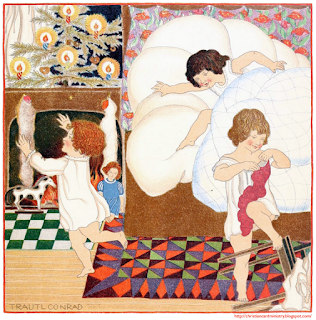Read his biography here.
We have all been brought up with the superstition, that efficiency in drawing and painting is the privilege of a few adults, that it can only be achieved after a long and arduous struggle, and by means only revealed to an intellectual oligarchy.
From time to time, however, the performance of some extraordinary child seems to throw a doubt on this belief and starts us wondering whether in face of such achievements, the result of a few tender years' work, the long efforts of maturity are not so much waste of misplaced energy.
 |
| "Santa Claus in his workshop" by Marta Zehenter |
The importance of the problem cannot be overlooked any longer. It goes further than aesthetic pure and simple, it opens a door upon the unexplored and somewhat disturbing processes of the human mind, and the child prodigy can no longer be looked upon as a freak.
Life, some will have it, is a never ending attempt at solving the sempiternal problems that have faced man since his first contact with realities; by seeking his knowledge through them, he evolved Science ; when he stretched his activities beyond contingencies in an endeavor to organize the forces hidden behind his consciousness, Art was born, Art, which was at the beginning Magic, and has remained Magic.
The Artist put at man's disposal a tangible world of unrealities by means of the most illusory elements, things that have no existence outside our senses, color, lines, sound, and made him master if he wished of a world that he could conjure up at will.
Through Art man becomes a child again, that is, his consciousness is lulled back into that sleep full of wonders from which he was tragically awakened by the phenomenon of the real world, and whose phantasmagoria lingered through his younger years.
We forget that we had those treasures of imagination, open to our hands and eyes and that we have deliberately buried them under the burden of our growing consciousness, and all the while the child is there refusing to part with them and sometimes making them visible and tangible for us and as perfect as the sophisticated fantasies of those of more mature years!
To our utter astonishment, he uses a technique which we associate with a training of many years, a fact most worthy of notice, for it is evident that a very good knowledge of drawing can be acquired in an incredibly short space of time, and this may lead to an extension of the methods that have accomplished such good results, not only in art, but in all branches of educational training: a different and better comprehension and use of all the different kinds of memories and associations of ideas.
 |
| "The Christmas Tree" by Bella Vichon |
Now, the child has this faculty developed to an extraordinary degree, because his subconscious organization is still unimpaired, and his mnemonic stimulants have not yet been completely replaced by conscious habits. The younger he is, the easier the process. Why then, should we view such accomplishments with wonder, and sometimes suspicion seeing that we take it for granted that the learning of languages, which involves a far more complicated mechanism, and is sometimes an impossibility to grown-ups, is the natural privilege of children?
Professor Cizek has successfully demonstrated with his methods that the scope of these unspoiled memory reflexes can be enlarged, and that because a child is taught to paint, he need not necessarily have in view Art as an end and a profession. Understood in that manner, it ought merely to form part of every child's education; it should not consist any more in the drudgery of drawing plaster casts or stuffed animals, but should aim at preserving the freshness and spontaneity of the subconscious machine that is still at our disposal in the lumber room of our childhood.
This would help us to develop a greater sense of balance between objective and subjective worlds, to lose the fear engendered by the paralyzing respect for cur own habits, and we might be able instead of taking our cue from the puzzling contingencies that surround us, to time realities to the rhythm within ourselves, and realize perhaps the perfect harmony described by the Chinese philosopher when he said:
"Last night, I dreamt I was a butterfly, and now that I am
awake, I do not know any more whether 1 am a man who dreamt
he was a butterfly, or a butterfly dreaming he is a man."
 |
| "The Village Church on Christmas Day" by Steffi Kraus |
 |
| "A Christmas Dream" by Ine Probsta |
 |
| "The Three Kings" by Herta Zuckermann |
 |
| "Christmas Treasure" by Steffi Krauss |
 |
| "Christmas Stockings" by Trautl Conrad |
 |
| "Tired Out" by Marie Kind |
 |
| "A world of toys" by Gretl Hanus |
 |
| "A Christmas Feast" by Herta Zukermann |
 |
| "Christmas Preparations" by Trautl Conrad |
 |
| "On the Way to Church" by Herta Zuckermann |
 |
| "Silent Night" by Gretl Hanus |
 |
| "At the last moment" by Bella Vichon |

No comments:
Post a Comment
Welcome, I publish commentary closely connected to the topic. Thank you for participating.